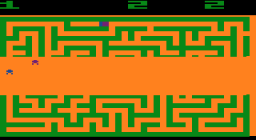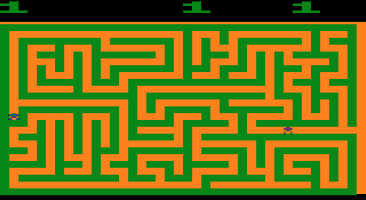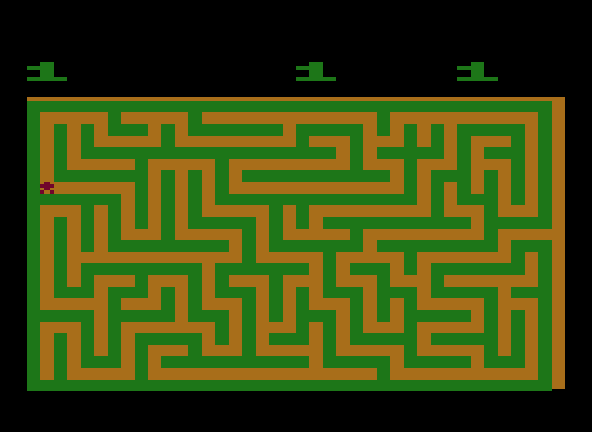Overall 8.2 Graphics 5.5 Sound 6 Addictive 8.5 Depth 9.5 Difficulty 2
8
Maze Craze Redrunelord
If one thing can be called inevitable, it is change. The world is growing more and more technically advanced, humans are evolving into machines which desires efficiency above all else. Eventually, humanity may reach the point of H.A.L 9000 with flesh and blood being replaced with cold steel, and compassion with pure logic. Even if humans do not reach said extreme, society is gravitating towards complete commercialism nonetheless, with families distant as gold glitters.
Lynyrd Skynyrd never agreed with this, and the says that to be true is to live simple: stop worrying about what needs not be worried about, and live in a way that is free from such. In an unusual manner, the Atari2600 both encompasses simplicity and complexity: while comparatively simple to modern gaming, it was considered high tech for the day and overly complicated. In some respects, that represented H.A.L 9000 in that technology is having its influences in the western world. Looking back now, most games would call it primitive but technically the true test for a game is how engaging and fun it is: not how many polygons are plastered across screen. Thus, how do a game like Maze Craze hold up 30 years later and beyond?
This is one of those games that is simple in principle but in reality is complicated at the same time. Maze craze is a game where the player would attempt to complete a maze before their opponent while avoiding the "cops". The game has a variety of modes but the objective largely remains the same. The player would take control of one of two personal and try to race the other to the end of the maze should a second player be available. Alternatively, the player could play alone and try time trials to get to the end of the maze. It is possible in both cases to have various enemies the player has to avoid moving throughout the maze; hit one, and that player is out. Last one alive or first one to the end wins. For what it is...it works extremely well. To actually pick it up and play it can be perceived as addicting and the average player should find that it isn't flawed in some convoluted way.
Visually, the game is simple and straightforward, but that is all it needs to be. Some similar games tries to hide behind a gimmick, but here there is only the puzzle, possible AI, and the players. In the end, that is all the visual complexity such a simple game requires.
The term simple is used a lot when describing games like this, and in many regards it is the single best word to use. The audio is rather standard fare for the Atari2600 with very little to say that can't be said about a plethora of other titles. In that sense, it is generic by the console's standards but those who appreciates the styling shouldn't have any issues with it.
This game do have a few technical marvels for the console, if the audio itself doesn't quite hold up. For instance, the mazes that appear on screen are not pre-recorded: rather, they are all actually randomly generated around a base code. Random generation for something that has to be completed is quite a marvel in itself, but what was and is even more astounding is how long it would take. Traditionally, similarly powered computers would require several minutes to generate a maze without glitches. However, in Maze Craze it would only take a few seconds. Even today the time necessary for the random generation is quite amazing for a puzzle game that has to be completed. This is important because one of the biggest irritations for gamers examining older consoles or computers in general is losing patience for various reasons, such as with load times (The Commodore 64 in particular is notorious for having long load times). With a lack of load times and a wide array of potential mazes, this improves how well the game holds up.
Another noteworthy technical accomplishment is how much diversity the actual game play has. Theoretically, a game where the player has to reach the end of a Maze is rather limited in diversifying the actual experience, especially if the system is technically limited in itself. However, for what the developers had to work with, it is clear they tried to add a number of modes if rather limited. The game`s main modes are increasing the number of enemy pieces and blocking out the maze. The way the latter works is that the screen would flash the maze`s path quickly then it would be invisible in a sense. The player can still navigate through but it can not see where the walls are until this flash comes. This adds a whole new level of challenge based on how much the player chooses to omit. A few basic modes that adds a lot of content to this game without sacrificing the relative simplicity.
This is one of those games that benefits from the utilization of an emulator because of the controls. This game was originally meant to be performed with an Atari2600 joystick which could be difficult to use to those unaccustomed. The emulator uses the keyboard which is perfect for a game like this...in single player. Admittedly with all hot seat PC games that uses the keyboard, it can be difficult to share the keys equally but it isn't an impossible feat for the emulator.
In conclusion, Maze Craze is one of those games that are deceptively simple, and easy to overlook in the modern day and age, yet holds up extremely well. The fact of the matter is that it is a simple game to pick up and play, and an excellent multiplayer experience. This game is a recommendation to any player who wishes to play a thinking game on a vintage video game console or anyone who has someone to play hot-seat games with and desires some Atari fun. It is obvious that the developers put genuine effort into creating a technically capable game that would differ from the masses of games on the system...and they succeeded.
Graphics 9 Sound 5 Addictive 7 Depth 9 Difficulty 3
Review Rating: 5/5
Submitted: 12-28-11
Review Replies: 0


 User Notice
User Notice 







